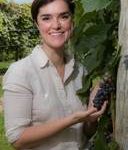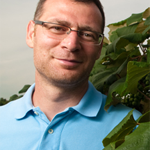April 3, 2017
My predecessor and longtime mentor Lorraine Berkett always told me to be ready for the growing season to start any time after April 1. After receiving another eight inches of snow at my house on April 1 this past weekend, I feel safe in saying that we still have a bit more time to go before bud break. That said, we do need to be ready, and these first few weeks of spring are important ones to get caught up on pruning, reviewing previous seasons’ activities, and laying out our plans for the coming year.
While I confess I haven’t done any bud dissections yet to assess winter injury to grapevines, after ten years of collecting that data I feel pretty confident in saying that the winter we are coming out of was not severe enough to cause widespread bud damage and that growers should prune as usual without adjusting for winter damage. While larger vineyards have been at it throughout the winter, pruning in many smaller vineyards that can be done in short time is often put off until as late as possible in order to potentially delay bud break and avoid working in the coldest of winter conditions. I also feel pretty confident that the major cold weather that could cause damage to buds, canes, and trunks is behind us, so if you haven’t done so, get pruning.
Late winter is a good time to review your previous season’s spray records and to identify any gaps that may have led to disease issues. Because the 2016 growing season was unusually dry, many vineyards did not have disease issues, even if spray schedules were a little ‘loose’, but growers should be prepared to maintain a full preventative disease management program in 2017. I recently revised two documents that Dr. Berkett had written on managing disease in cold-climate grapes: a table of relative disease susceptibility of cold-climate cultivars and an initial IPM strategy for cold climate winegrapes. Additionally, the 2017 New York and Pennsylvania Pest Management Guidelines for Grapes are now available and should be used in combination with specific pesticide labels to select pesticide materials for use in your IPM program.
One pesticide spray that is often considered by growers is a dormant application of lime sulfur (LS) which aids in inoculum reduction against many diseases, especially phomopsis and anthracnose. Growers who have had more than a passing amount of either of those diseases, as well as organic growers with more limited choice of materials during the growing season may consider applying this practice, but I make that recommendation with several caveats. While LS is an organically-approved pesticide, it is one of the most acutely toxic materials I have ever used, and demands special considerations for its use. It is also a restricted-used spray material, so unlicensed applicators may not purchase or apply it. LS (active ingredient calcium polysulfide) is very caustic; spray mixtures tend to have pH around 10-11, and that characteristic is what gives it its sanitizing effect as a biocide. Contact with skin or especially eyes must be avoided, and it is pretty noxious even through a respirator. This material demands respect. While those effects will dissipate in the field after sufficient washoff and degradation by rain and other elements, I would only plan on applying after pruning is finished so not to muck around in it after application. In fact, very thorough pruning out of all dead and diseased wood is an important cultural disease control practice, and if you have a lot of such wood left in the vineyard, spraying your way around pruning it out won’t help.
LS is typically labeled for application at “15-20 gallons per acre in sufficient water for coverage” (Miller Liquid Lime Sulfur). That is a very high amount of LS, and would be difficult to apply and very costly when applied to large acreages. The key is to fully soak all woody tissues in the vineyard. This may mean aiming all nozzles at the cordons, but that would leave the trunks uncovered. Alternatively, the sprayer could be operated to cover the whole zone from the fruiting wore down, which would waster a tremendous amount of spray. The best application may come from a careful handgun application, which will take a long time and should be done with full protective gear including heavy nitrile gloves, full face shield and respirator, and Tyvek or other chemical-resistant, disposable coveralls. It is hard to say how much you would apply per acre in a directed spray, since that would be much more efficient with less wasted spray than an airblast application. My suggestion would be to apply a 10% solution (1 gallon LS to 9 gallons water) by handgun to cordons and trunks in a very thorough soaking spray. If you need to use an airblast to cover more ground, I would concentrate my nozzles toward the cordons but leave one or two directed toward the trunks, that will waste spray between vines but will allow you to cover ground much quicker. Because of the reduction in efficiency, I would calibrate to apply ten gallons of LS per acre in at least fifty gallons of water.
Remember, this stuff is caustic, stinky, and degrades just about everything it touches. It’s also quite phytotoxic- application at these rates to vines after bud break will cause leaf damage if not outright defoliation. I have used a lot of LS during the growing season in organic apple production, and don’t recommend it there unless absolutely necessary. I do not have experience using it in-season (post-bud break) on grapes, so this recommended spray must be applied during the window between pruning and bud break. The spray, if left on tractors and in sprayer plumbing, will corrode hoses, gaskets, and even stainless steel. It must be thoroughly rinsed from sprayer systems and the rinsate applied back out in the vineyard, not dumped on the ground. Some growers have applied a film of vegetable oil via backpack prayer to tractors and sprayers before an LS application to prevent it from soaking into and corroding steel and other materials on equipment. It’s that bad, and I could show you sprayer hitches, mix screens, and ceramic nozzles that have been degraded by it.
With all that said, LS is extremely effective as a preventative practice to reduce disease inoculum, and I still recommend its use in vineyards where anthracnose and/or phomopsis have gotten a bit out of control. Just be careful out there and treat it with the same (and a little more) respect that you should retreat any pesticide.





